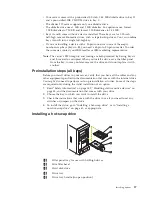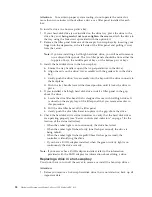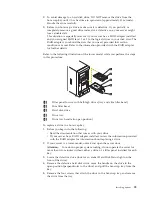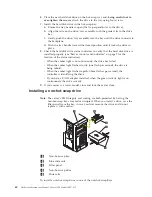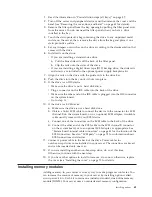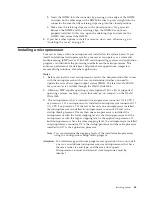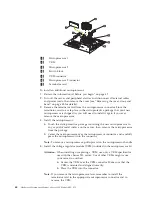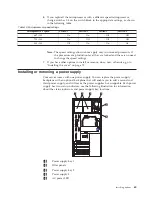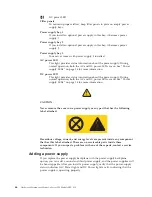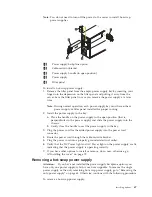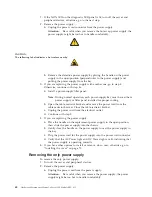
b.
Insert
the
DIMM
into
the
connector
by
pressing
on
one
edge
of
the
DIMM
and
then
on
the
other
edge
of
the
DIMM.
Be
sure
to
press
straight
into
the
connector.
Be
sure
that
the
retaining
clips
snap
into
the
closed
positions.
c.
Make
sure
the
retaining
clips
are
in
the
closed
position.
If
a
gap
exists
between
the
DIMM
and
the
retaining
clips,
the
DIMM
has
not
been
properly
installed.
In
this
case,
open
the
retaining
clips
and
remove
the
DIMM;
then,
reinsert
the
DIMM.
5.
If
you
have
other
options
to
install
or
remove,
do
so
now;
otherwise,
go
to
“Installing
the
cover”
on
page
70.
Installing
a
microprocessor
Your
server
comes
with
one
microprocessor
installed
on
the
system
board.
If
you
install
an
additional
microprocessor
kit,
your
server
can
operate
as
a
symmetric
multiprocessing
(SMP)
server.
With
SMP,
certain
operating
systems
and
application
programs
can
distribute
the
processing
load
between
the
microprocessors.
This
enhances
performance
for
database
and
point-of-sale
applications,
integrated
manufacturing
solutions,
and
other
applications.
Notes:
1.
Before
you
install
a
new
microprocessor,
review
the
documentation
that
comes
with
the
microprocessor,
so
that
you
can
determine
whether
you
need
to
update
the
server
basic
input/output
system
(BIOS).
The
latest
level
of
BIOS
for
your
server
is
available
through
the
World
Wide
Web.
2.
Obtain
an
SMP-capable
operating
system
(optional).
For
a
list
of
supported
operating
systems,
see
http://www.ibm.com/pc/us/compat/
on
the
World
Wide
Web.
3.
The
microprocessor
that
is
installed
in
microprocessor
connector
U3
is
CPU
1
or
processor
1.
If
a
microprocessor
is
installed
in
microprocessor
connector
U17,
it
is
CPU
2
or
processor
2.
If
the
server
has
only
one
microprocessor
installed,
that
microprocessor
is
installed
in
microprocessor
connector
U3
and
is
the
startup
(boot)
processor.
If
more
than
one
microprocessor
is
installed,
the
microprocessor
with
the
lower
stepping
level
is
the
startup
processor
and
the
microprocessor
with
the
higher
stepping
level
is
the
application
processor.
If
both
microprocessors
have
the
same
stepping
level,
the
microprocessor
installed
in
microprocessor
connector
U3
is
the
startup
processor
and
the
microprocessor
installed
in
U17
is
the
application
processor.
Note:
You
can
determine
the
stepping
levels
of
the
installed
microprocessors
using
the
Configuration/Setup
utility
program.
Attention:
To
avoid
damage
and
ensure
proper
server
operation
when
you
install
a
new
or
an
additional
microprocessor,
use
microprocessors
that
have
the
same
cache
size
and
type,
and
the
same
clock
speed.
Microprocessor
internal
and
external
clock
frequencies
must
be
identical.
Installing
options
63
Содержание xSeries 230 6RY
Страница 1: ...Hardware Maintenance Manual xSeries 230 Models 6RY 61Y...
Страница 2: ......
Страница 3: ...Hardware Maintenance Manual xSeries 230 Models 6RY 61Y...
Страница 20: ...12 Hardware Maintenance Manual xSeries 230 Models 6RY 61Y...
Страница 38: ...30 Hardware Maintenance Manual xSeries 230 Models 6RY 61Y...
Страница 48: ...40 Hardware Maintenance Manual xSeries 230 Models 6RY 61Y...
Страница 126: ...118 Hardware Maintenance Manual xSeries 230 Models 6RY 61Y...
Страница 132: ...124 Hardware Maintenance Manual xSeries 230 Models 6RY 61Y...
Страница 167: ...Related service information 159...
Страница 168: ...160 Hardware Maintenance Manual xSeries 230 Models 6RY 61Y...
Страница 169: ...Related service information 161...
Страница 170: ...162 Hardware Maintenance Manual xSeries 230 Models 6RY 61Y...
Страница 171: ...Related service information 163...
Страница 172: ...164 Hardware Maintenance Manual xSeries 230 Models 6RY 61Y...
Страница 173: ...Related service information 165...
Страница 174: ...166 Hardware Maintenance Manual xSeries 230 Models 6RY 61Y...
Страница 184: ...176 Hardware Maintenance Manual xSeries 230 Models 6RY 61Y...
Страница 185: ...Related service information 177...
Страница 186: ...178 Hardware Maintenance Manual xSeries 230 Models 6RY 61Y...
Страница 193: ......
Страница 194: ...Part Number 19K6112 Printed in USA 1P P N 19K6112...









